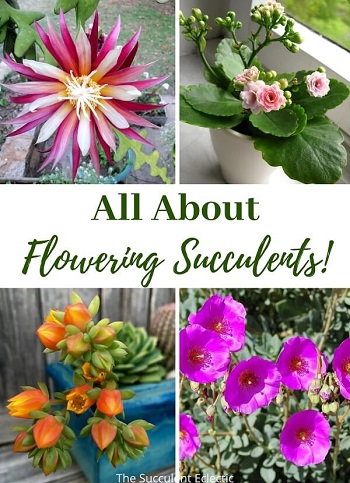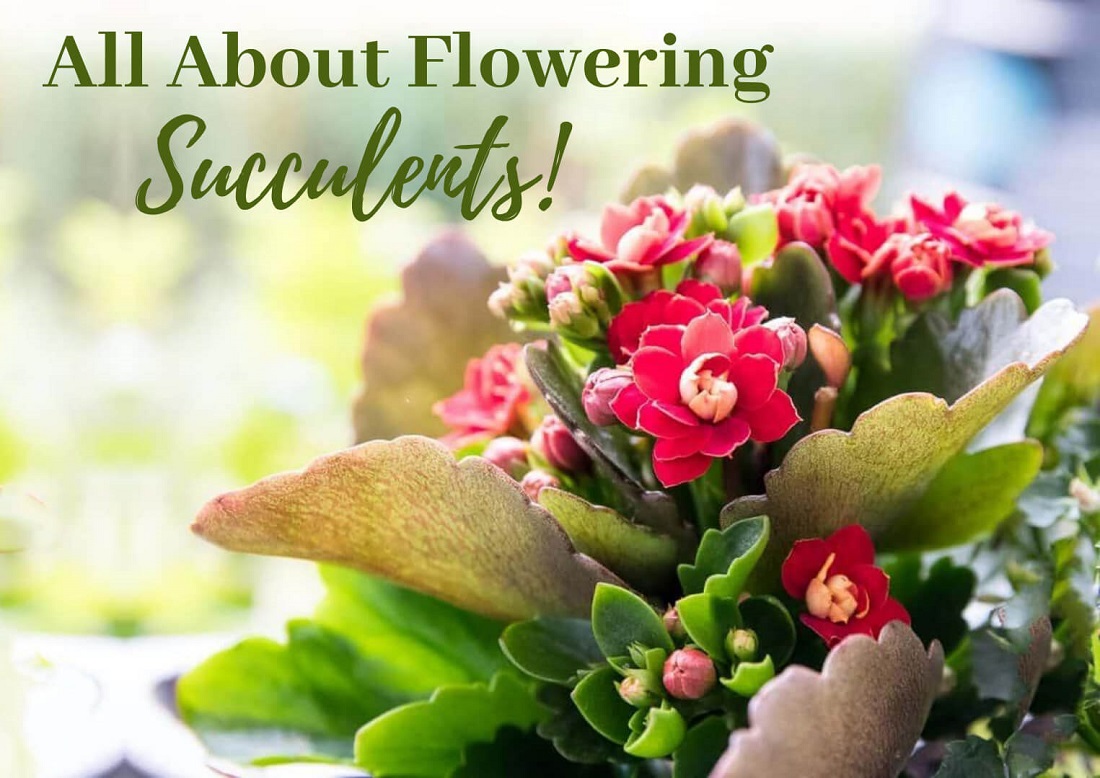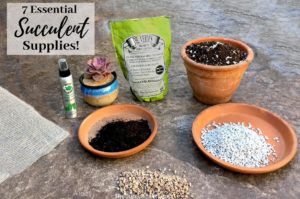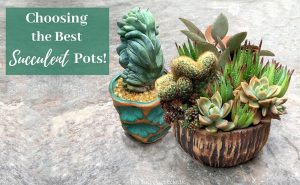Let’s talk about flowering succulents. Succulents have such a beautiful, sculptural appeal, often looking like flowers themselves. Many succulent enthusiasts simply ignore succulent blooms because it’s the foliage and structure that appeals to them most. But these beauties should not be overlooked. Succulents and cacti produce some of the most magnificent flowers on the planet! Let’s take a look at succulents that bloom and exactly how to care for them when they do. Worried about the dreaded death bloom? Worry no longer. We’ll cover that, too. Then, let’s look at the 16 best flowering succulents that bloom year after year!
{Please note, some links in this post may be affiliate links to sites that pay me a small commission if you click on the link and make a purchase. This commission is at absolutely no cost to you. I only recommend products and companies that I have worked with and truly love! ~Kat}
We’re going to cover everything you need to know about flowering succulents, their care, how flowers affect the plant, and more. This is a looooong post with a ton of information! Skip ahead if you’d like to the info you’re most interested in:
Flowering Succulents
In this Post We'll Cover:
- Flowering Succulents
- What is a Death Bloom?
- Succulent Flowering Plants Attract Pollinators
- What to Do When Your Succulent Blooms?
- Don’t Be Fooled – These Aren’t Succulent Blooms!
- 16 Best Flowering Succulents
- Kalanchoe blossfeldiana
- Aloe – All Varieties
- Epiphyllum anguliger – Ric Rac Cactus
- Echeveria – All Varieties
- Delosperma – Ice Plant
- Rebutia fiebrigii – Crown Cactus
- Schlumbergera truncata – Thanksgiving Cactus
- Crassula ovata – Jade Plant
- Euphorbia milii – Crown of Thorns
- Calendrinia spectabilis – Rock Purslane
- Crassula perfoliata falcata – Propeller Plant
- Hoya carnosa – Indian Rope Plant
- Stapelia — All Varieties
- Adenium obesum – The Desert Rose
- Portulaca oleracea
- Sedum telephium ‘Autumn Joy’
- Flowering Succulents Frequently Asked Questions (FAQs)
- Are You Ready to Grow Some Flowering Succulents?
What is a Death Bloom?
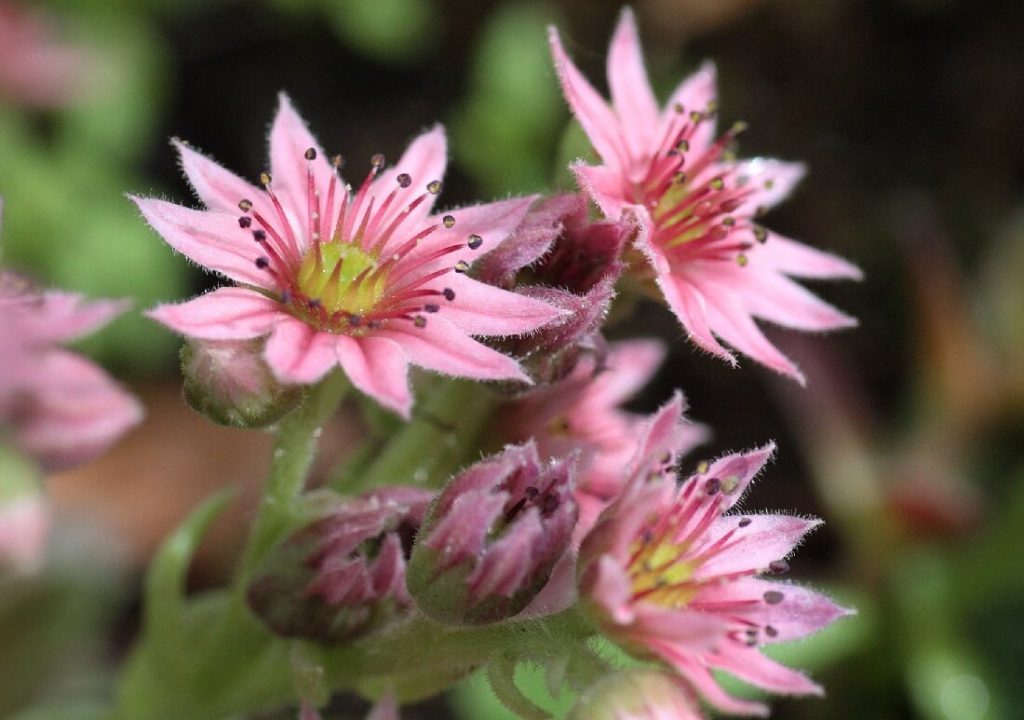
Scroll through gorgeous photos of succulents on social media. When you see a succulent flowering plant, it never fails — someone will say, “Oh no! Is that a death bloom?” What are they talking about?
Some flowering succulents are monocarpic, meaning they bloom and set seeds just once before they die. This is how they sexually reproduce themselves in nature. Typically, these are compound flowers, and the plant will elongate as it develops its flower stem. It may take anywhere from a single year to decades for these succulents to bloom. They spend their entire lives building up their energies to form this bloom. In that the flowering signals the time the succulent begins to die, the “death bloom” has some accuracy. But these plants first produce many, many offsetsSucculent offsets are the baby succulents that form at the b... that continue to live on long after the mother plant dies. This is the plants’ asexual or vegetative reproduction.
Do not fear the death bloom! When an Agave or Sempervivum or other monocarpicMonocarpic (Mon-oh-CAR-pic) plants are those that flower, se... succulent blooms, it doesn’t leave a bare spot behind in the garden or pot when it dies. Many baby plants take its place. I know I’ll never convince some not to fear these monocarps, so my list of the 16 best flowering succulents doesn’t contain a single one!
Succulent Flowering Plants Attract Pollinators
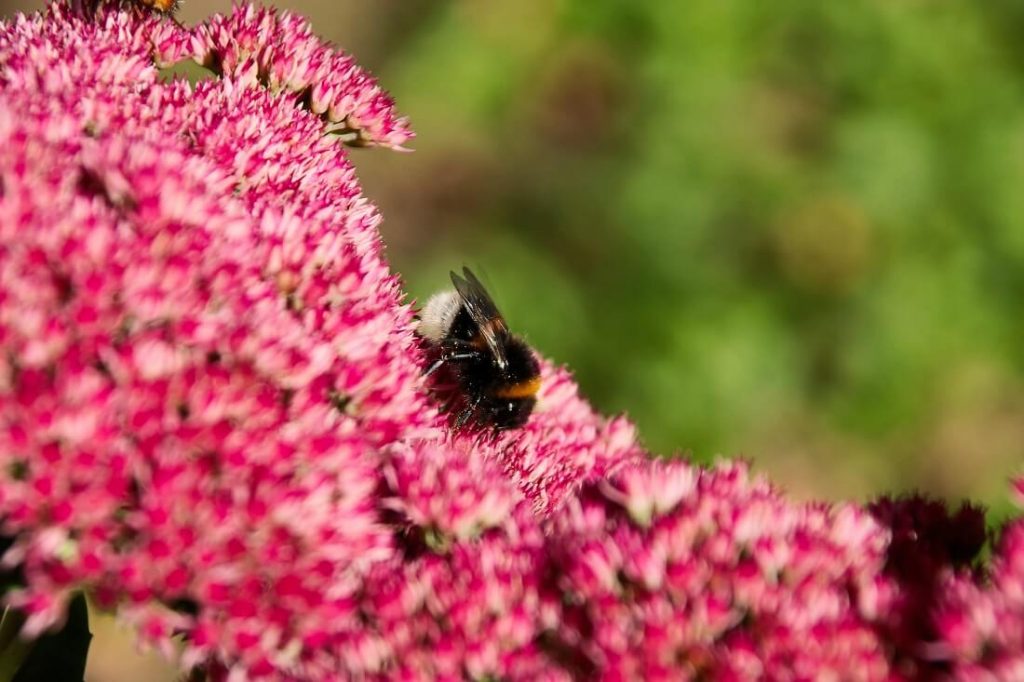
Succulents flower to attract pollinators. This enables them to mingle their seeds with the pollen of other plants to strengthen the genetics of the next generation. This is the essence and the advantage of sexual reproduction — a genetic roll of the dice with the chance to improve the species. Vegetative reproduction repeats the genes of a plant that has proven successful.
Learn which flowering succulents attract pollinators like bees, butterflies, moths, hummingbirds, and bats too! (Don’t frown! Without bats, there would be no tequila!).
What to Do When Your Succulent Blooms?
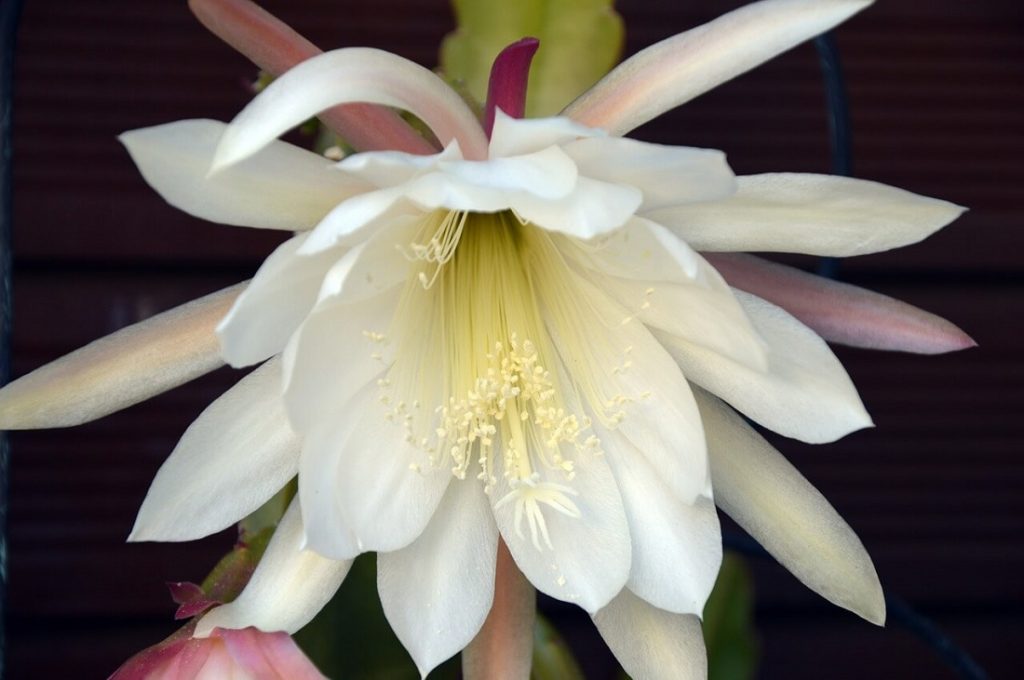
So, what do you do when your succulent blooms? In the case of Epiphyllum oxypetalum, you celebrate! The blooms are so extraordinary in their beauty and fragrance, and they last just a single night. Many people around the world throw a party to celebrate these astonishing blooms!
Not all flowering succulents get a party. (Wouldn’t it be awesome if they did?) When a succulent blooms, you have a choice. Do you let it flower or not? It takes a lot of energy and resources to produce blooms. If your plant is small, or your goal is to grow succulents more quickly, don’t let it bloom. Instead, cut the stem near the plant, even before the flowers fully form and open. This stops the succulent from blooming. More importantly, it makes the flowering succulent redirect its energies back into growing more plant. Your succulent will grow larger faster this way. The flower stem of some succulents can be propagated. Others form leaves on the flower stem that can be rooted. If the flowers have already opened, you can slip them into a bud vase with water, where they will last a long time!
Some succulent blooms attract pests. Echeveria flowers, in particular, are highly attractive to aphids. I prevent pests on my succulents with worm castings. Others cut the stems of their Echeveria blooms to keep pests down. And some try to prevent the death bloom described above by cutting the flower stems before they fully mature. Some claim to have had success with this. I prefer to let my succulents develop more naturally, so I cannot attest to this technique.
Don’t Be Fooled – These Aren’t Succulent Blooms!
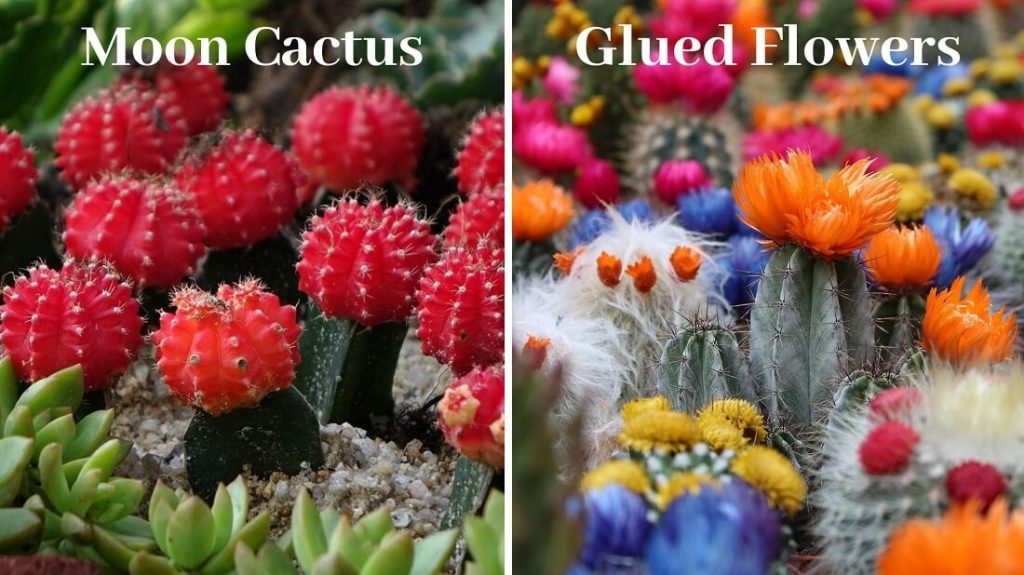
Moon cacti are those intriguing curiosities that look like living lollipops. These bright red balls are not flowers. Those are the very colorful Gymnocalycium mihanovichii grafted onto the straight, green stem of a Hylocereus rootstock. The red cactus will remain red as long as the grafted cactus is healthy.
The colorfully blooming cacti on the right are not blooming at all. These are dried, dyed strawflowers glued to the top of various cacti. Learn all about this and succulent scams. Most “blooming cactus” you see at home stores, and nurseries are these, with glued-on flowers. So, how can you tell the difference between these fake flowers and the real deal?
- Cactus flowers feel soft, cool, and silky smooth to the touch
- Cactus flowers form at the end of short stems
- Most cactus flowers emerge from the side of the plant rather than directly on top
- Cactus flowers last up to several days, not weeks or months
16 Best Flowering Succulents
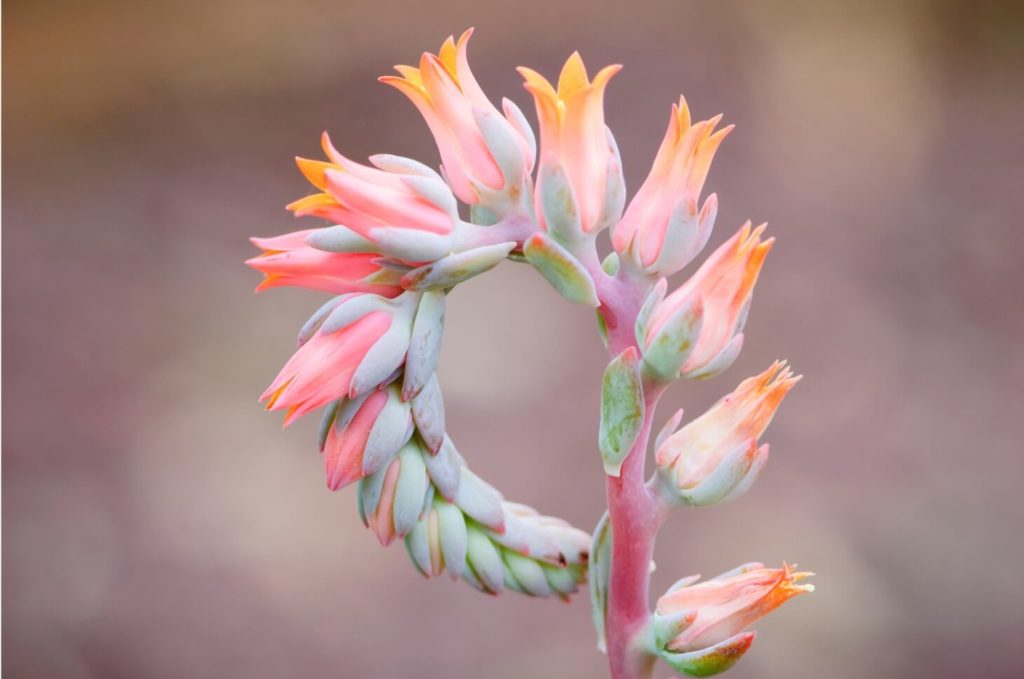
Now that we’ve covered all the important background for succulent flowering plants, their care, and even scams, let’s get to the fun part! Flowering succulents are proof that sometimes, you really can have it all. If you love flowers, succulent plants are a great choice! You’ll find some cold-hardy varieties and some for growing indoors. Some blooms last a very short time but are so spectacular they earned their place here. Others last for months!
Flowering succulents can fill several roles in your garden. Some make attractive succulent ground covers in a range of climates. Others are wonderful hanging succulents. You’ll find some flowering succulents are exceptionally cold hardy. Read on for my top 16 flowering succulents. Not a death bloom on the list!
Kalanchoe blossfeldiana
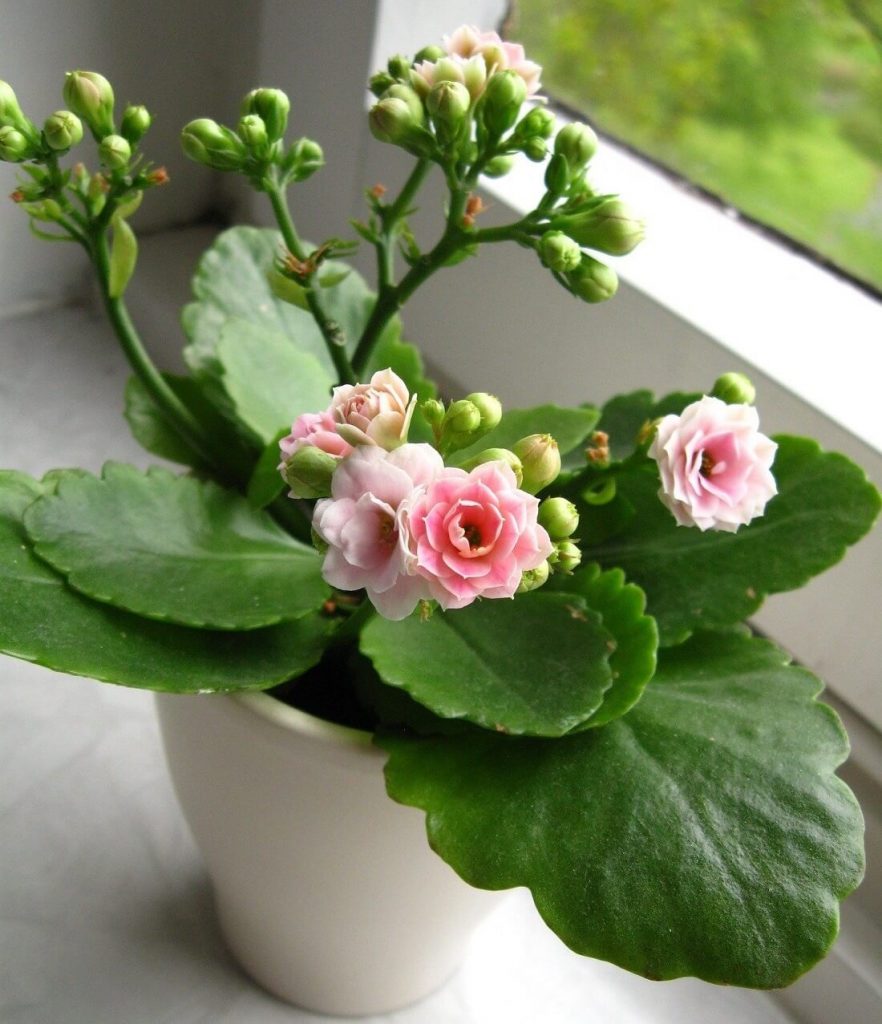
Kalanchoe blossfeldiana is a stellar flowering succulent that thrives indoors or in shady conditions outside. It is commonly called a Christmas Kalanchoe or flaming Katy and can be found in many supermarkets or home stores. Glossy green foliage is attractively scalloped and highlighted by hundreds of blooms! Most often found in single flower form, this succulent blooms in all shades of red, pink, yellow, peach, orange, and white. The plant above, with the double pink succulent flowers, will bloom for months at a time. There is a specific technique to getting Kalanchoe blossfeldiana to rebloom, but once you know it, it is easy to achieve! Protect this beauty from frost.
Indoor:
Aloe – All Varieties
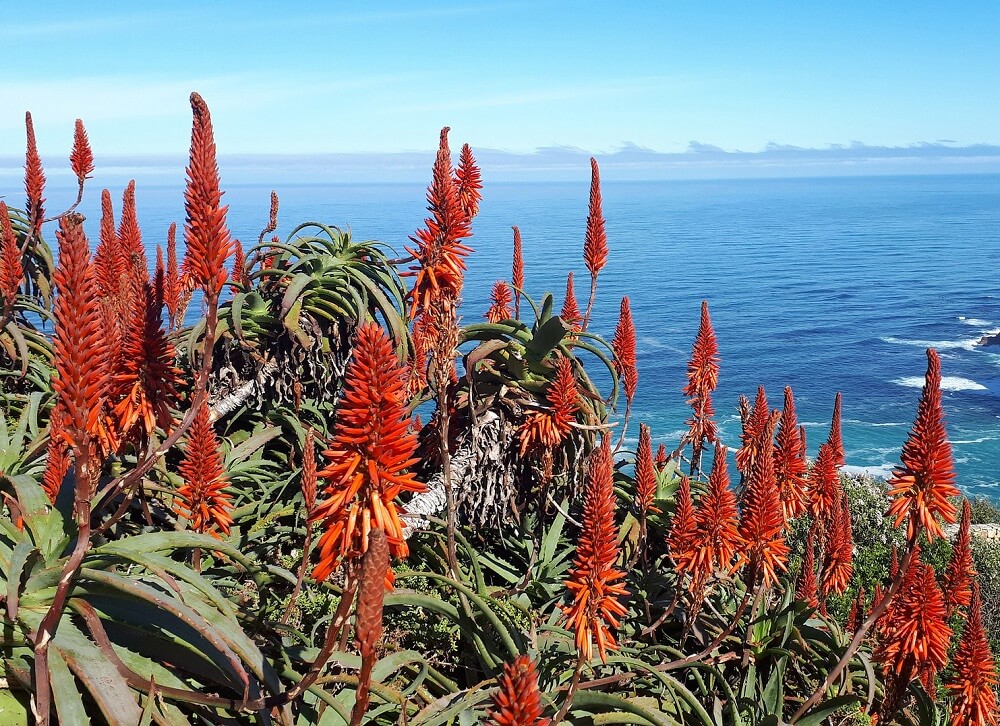
There are over 500 species of Aloe in the world, and all of them produce tall spires of brightly colored tubular blooms that beckon to hummingbirds. Some bloom canary yellow, others in scarlet, and still others produce bi-colored flowers. Many Aloe grow well indoors or out, but the best flower production occurs outdoors with a lot of sunshine. When well-established, this succulent flowering plant blooms heavily in summer, with occasional blooms occurring in spring and fall. While some Aloe tolerate temps below freezing, most are tender to frost.
Epiphyllum anguliger – Ric Rac Cactus
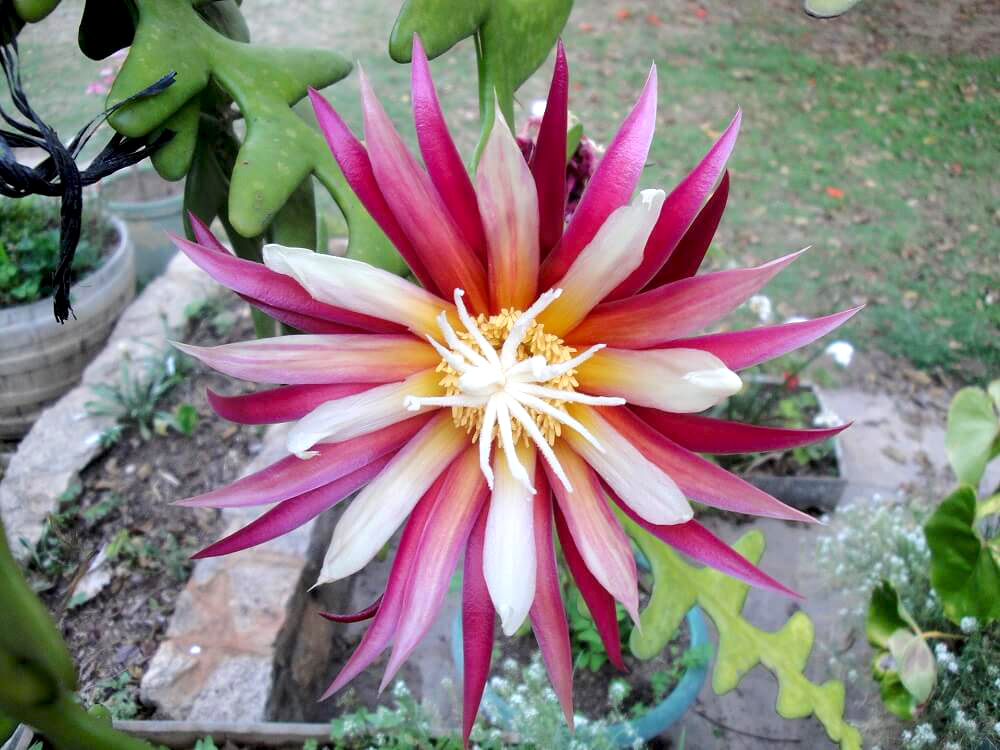
This stunning succulent flowering plant is an Epiphyllum anguliger, commonly called a ric rac cactus or a fishbone cactus for the odd foliage-like stems it produces. The ric rac stems arch up and trail down, making for an intriguing hanging cactus. This is a spineless, epiphytic cactus native to Mexico, where it is found growing in the tops of leafy trees. The extraordinary white to creamy yellow to pink succulent flowers are wondrously fragrant and nocturnal. Ric rac cacti are easily grown from cuttings and must be protected from temperatures below 50° F (10° C). More warmth and light are needed for the best blooming. The flowers last just one night. Don’t miss it!
Echeveria – All Varieties
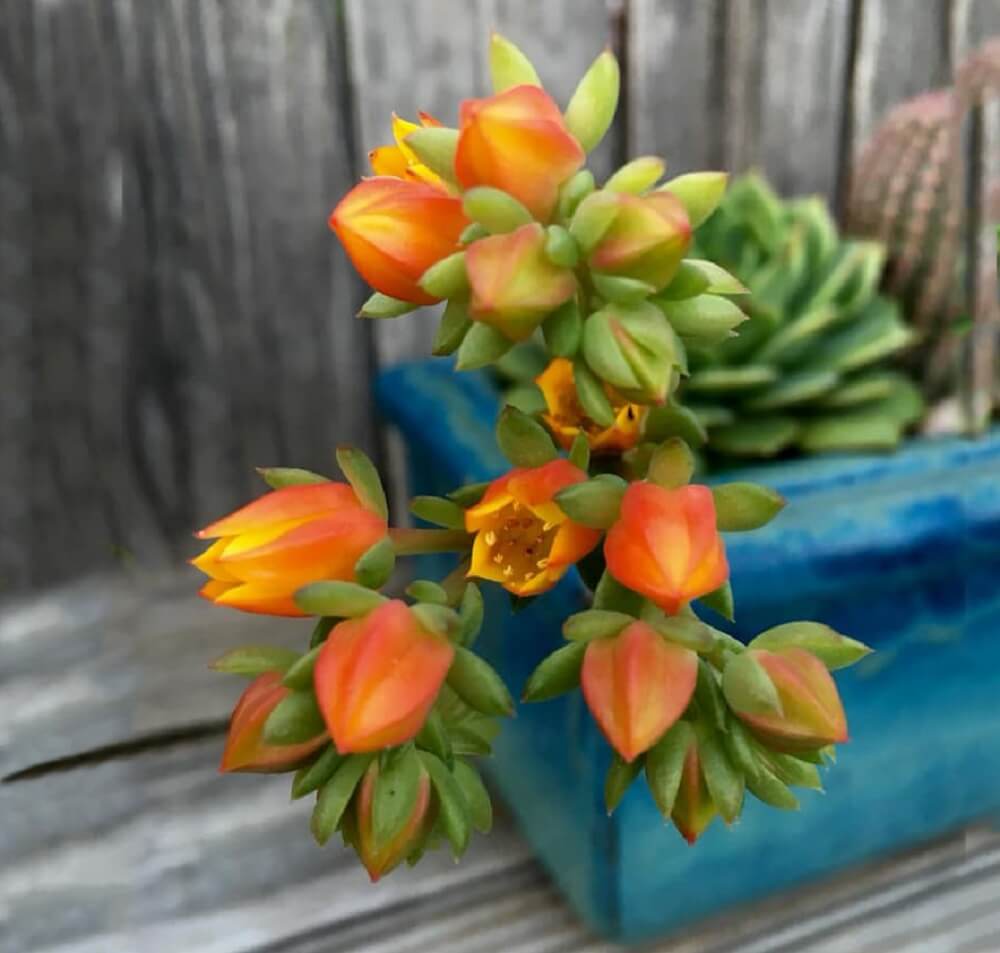
Is it surprising that the beautiful, rosette-forming Echeveria also produces arching stems of lovely, lantern-like blooms? Depending upon the variety, these succulent blooms in shades of pink, peach orange, and yellow. All are highly attractive to hummingbirds — and aphids. Keep the aphids and other pests at bay with worm castings. The blooms are long-lasting on the plant or in a bud vase. My thanks to Karen McCants for the use of her gorgeous photo. Check out KarenMcCantsArt’s spectacular succulent pots!
Echeveria:
————————————————————————————————
Delosperma – Ice Plant
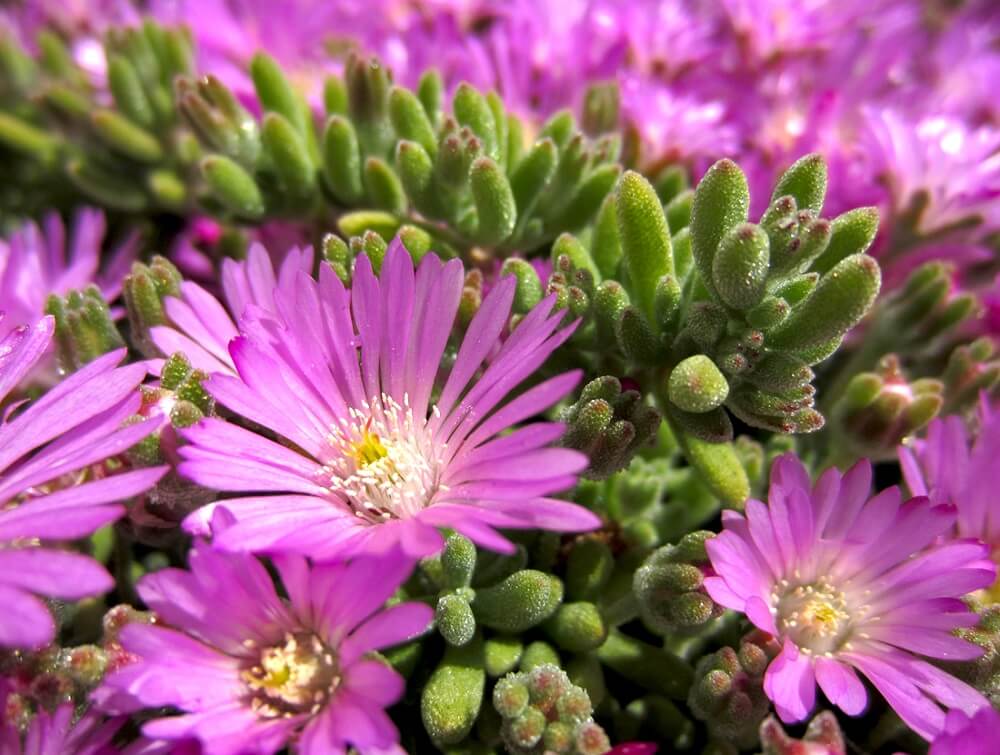
Delosperma, more commonly referred to as ice plant, is a stellar, cold-hardy flowering succulent that forms a blanket of colorful blooms in shades of white, red, yellow, and pink. The pink succulent flowers of Delopserma cooperi sparkle from mid-summer through mid-fall. Hardy to zone 6 (-10°F / -23 °C), this beauty is striking in hanging baskets or used as a succulent ground cover. It’s resistant to deer but attracts bees and butterflies. Delosperma grows and blooms its best in full sun.
Rebutia fiebrigii – Crown Cactus
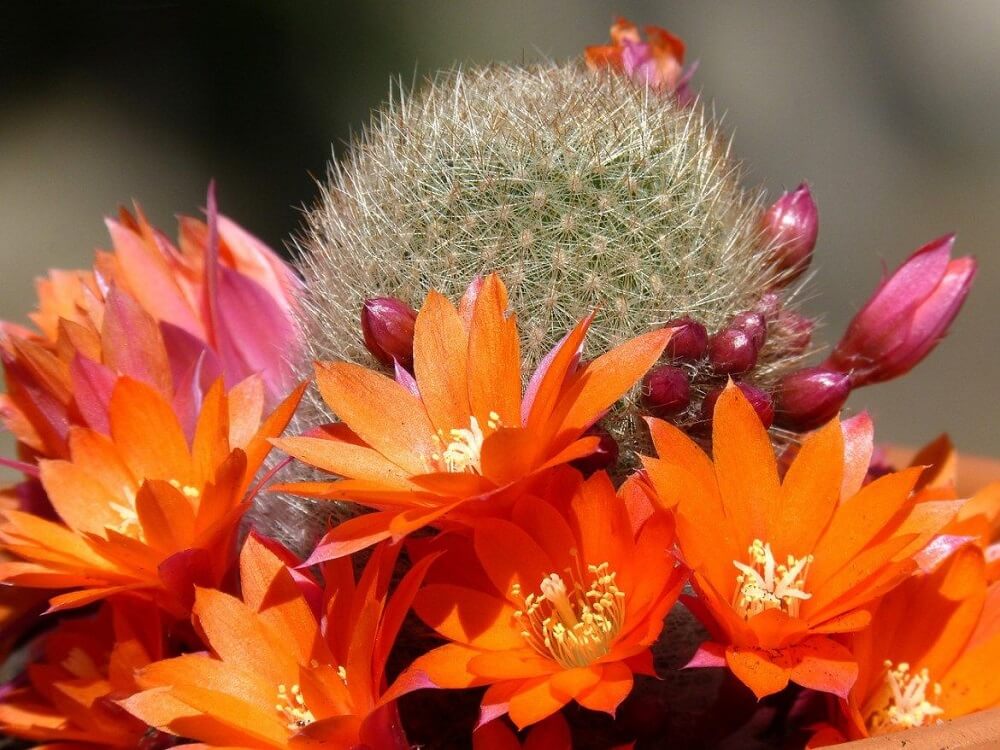
Rebutia fiebrigii, or crown cactus, is a small cactus that tops out around 3 inches tall. It begins as a solitary individual that eventually forms a small colony populated with offsets. Rebutia blooms in brilliant shades of red, yellow, orange, or white in late spring. The silky blooms last about six days. Easy to grow, this cactus thrives in full sun, fast-draining succulent soil with very little water. All cacti are succulents, and this is a beautiful flowering succulent!
Schlumbergera truncata – Thanksgiving Cactus
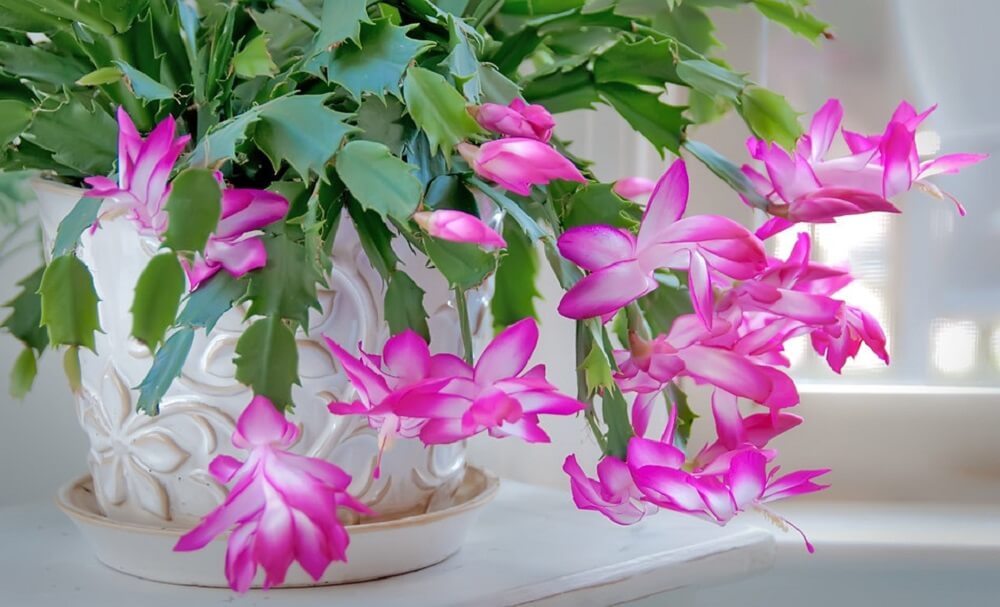
Ask someone about the best flowering succulents, and their thoughts will turn to the beloved and closely related Christmas, Thanksgiving, and Easter cactus. Schlumbergera is another epiphytic cactus that makes its native home in treetops. It bursts into spectacular bloom in shades of red, pink, and white for several weeks at a time. With proper care, it will thrive in the moderate temperatures and lighting in your home. Better yet, you can get Schlumbergera to rebloom. Compensate for dry conditions by misting the flattened stems a few times a month when the plant is not in bloom.
Crassula ovata – Jade Plant
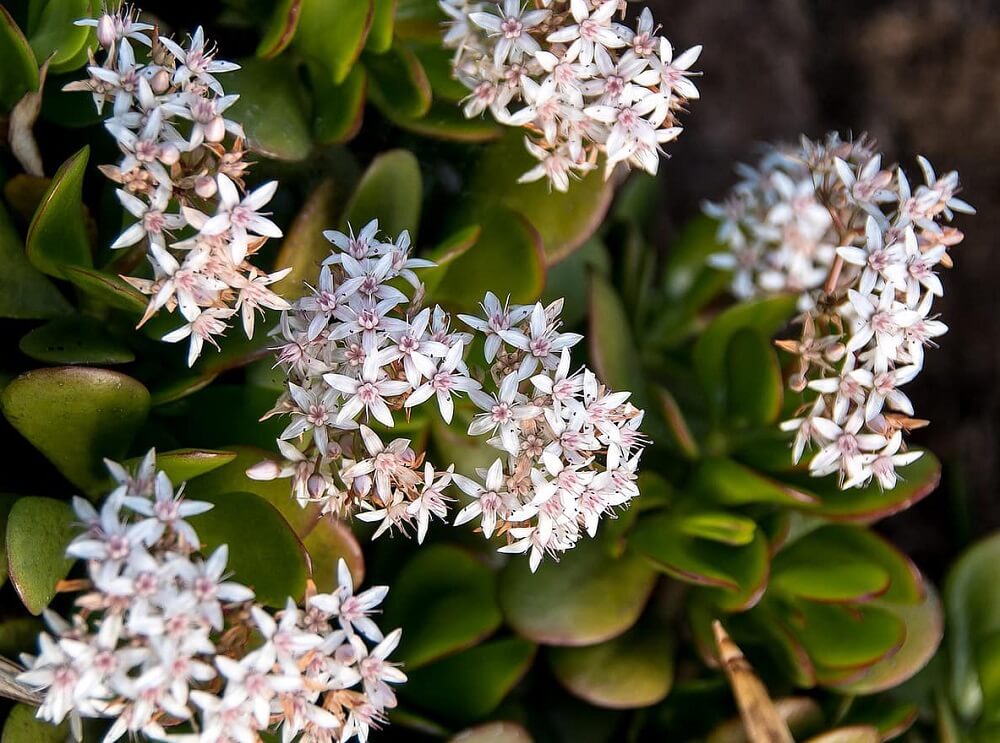
Crassula ovata is a well-loved succulent with many hybrids, better known as a jade plant. It grows well indoors or out, in shade to full sun. Because most people grow them indoors, they may be surprised to learn that their jade plant can bloom — profusely. To enjoy the blooms, grow your 3+ year mature Crassula ovata in a lot of sunshine. Clusters of starry-white blooms attract bees and butterflies and last for weeks in winter. Tender to frost, jade plants must be protected over the winter.
Euphorbia milii – Crown of Thorns
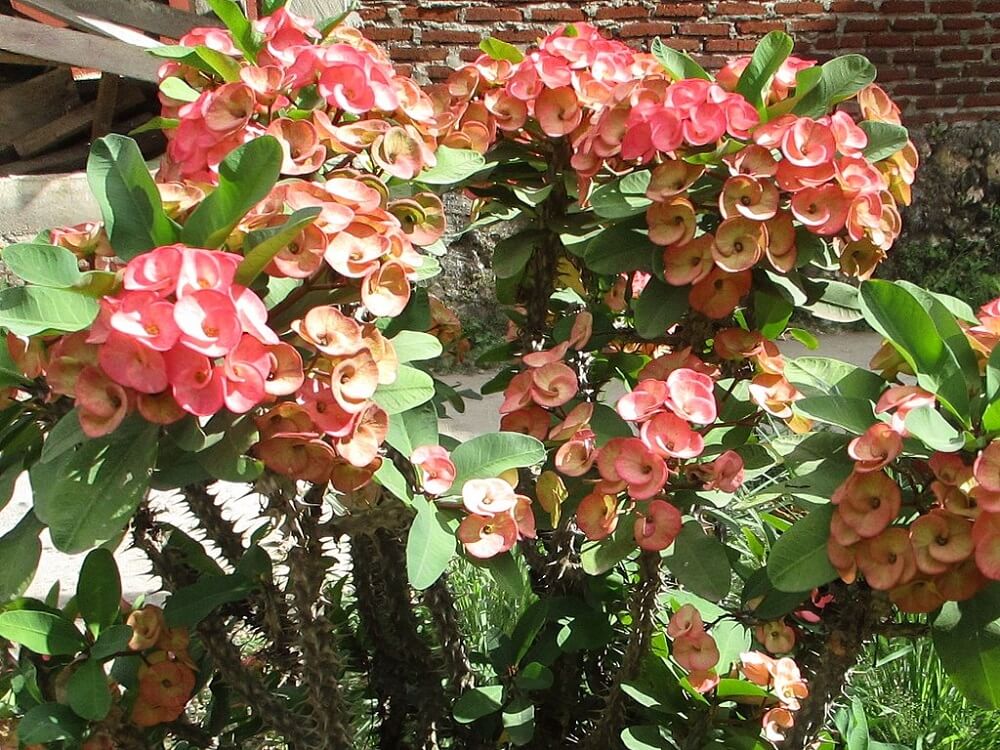
One of the most spectacular flowering succulents is Euphorbia milii, commonly known as the crown of thorns plant. This small, woody shrub has fierce thorns and a toxic sap. It forms dense clusters of simple blooms in a range of colors nearly non-stop throughout the year. Provide fast-draining soil, lots of sunshine, and regular watering. You’ll enjoy masses of colorful blooms. Treat this succulent flowering plant with respect and enjoy the low-maintenance spectacle!
Calendrinia spectabilis – Rock Purslane
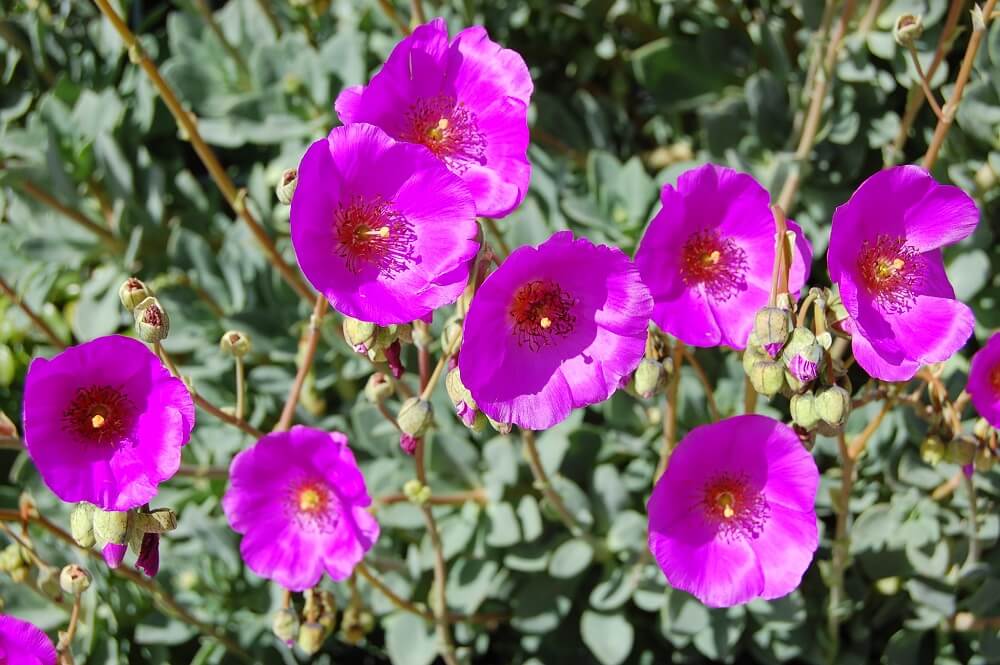
Calandrinia spectabilis is a spectacular succulent flowering plant native to Chile. It forms silvery foliage that reaches about 8 inches tall. Hot pink, poppy-like blooms float above the foliage on slim stems reaching 2 feet tall. The effect is magical and long-lasting. The bright pink succulent blooms emerge in spring and continue until fall. Fast-growing and low-maintenance, Calandrinia are charming landscape plants that thrive in full to partial sun. Hardy to zone 8 (10°F / -12.2°C).
Crassula perfoliata falcata – Propeller Plant
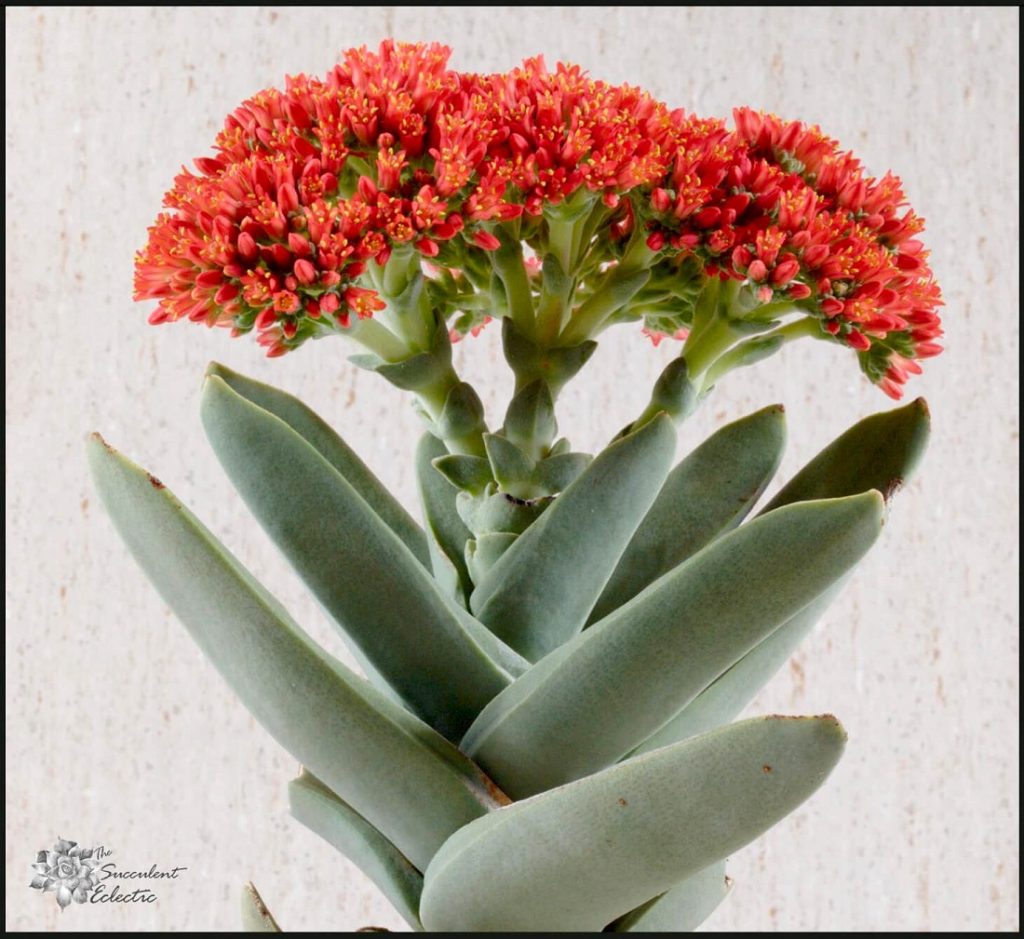
Crassula perforiata falcata — say that three times fast! — is better known as the propeller plant or the airplane plant for the unusual shape and arrangement of its silvery-grey leaves. Come summer, the propeller plant produces large clusters of scarlet blooms that last and last, whether left on the plant or in a bud vase. Outdoors, this flowering succulent is popular with bees and butterflies all season long. Crassula perforiata falcata thrives in bright, indirect sunshine. It is not hardy below zone 10 (30°F / -1.1°C) but can be over-wintered indoors.
Hoya carnosa – Indian Rope Plant
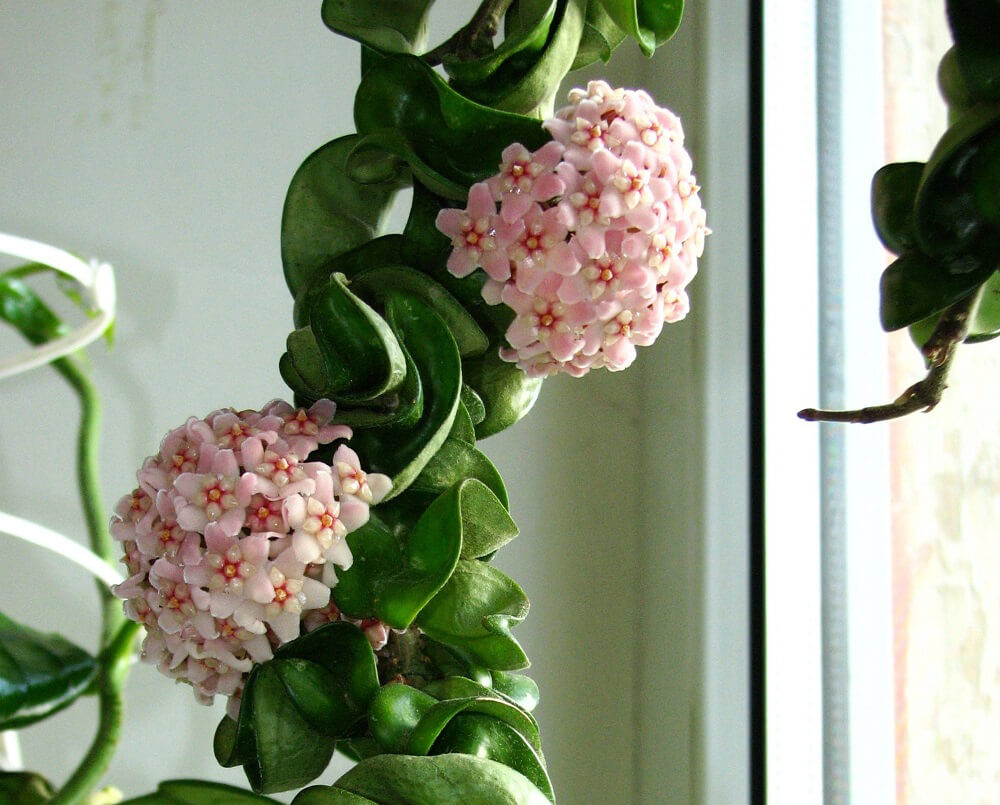
Hoya carnosa, commonly called the Indian rope plant or wax plant, is a cool, hanging succulent that produces clusters of wonderfully fragrant blooms. This flowering succulent is tender to temps below 50°F (10°C). It can grow well indoors year-round. Vines can reach up to 10′ in length with curled, waxy leaves that undulate around the central stem. For best blooming, provide abundant, bright light and keep the roots pretty pot-bound.
Stapelia — All Varieties
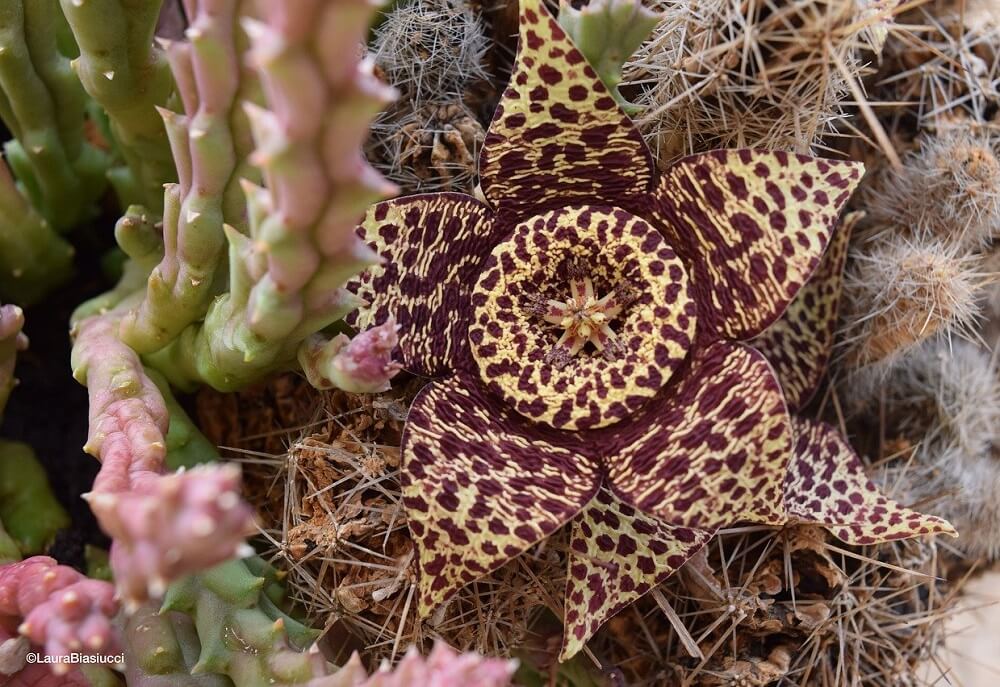
Stapelia is an odd, 4-sided cactus that produces spectacularly strange, sort of furry blooms. Commonly known as the starfish flower, Stapelia bloom large flowers that last a long time. A full flush of blooms in late spring with a sprinkling of flowers in summer and a bigger bloom in fall. This flowering succulent thrives in fast-draining soil with abundant light and can be made happy indoors. Protect Stapelia from temperatures dipping below 30°F (-1.1°C).
Adenium obesum – The Desert Rose
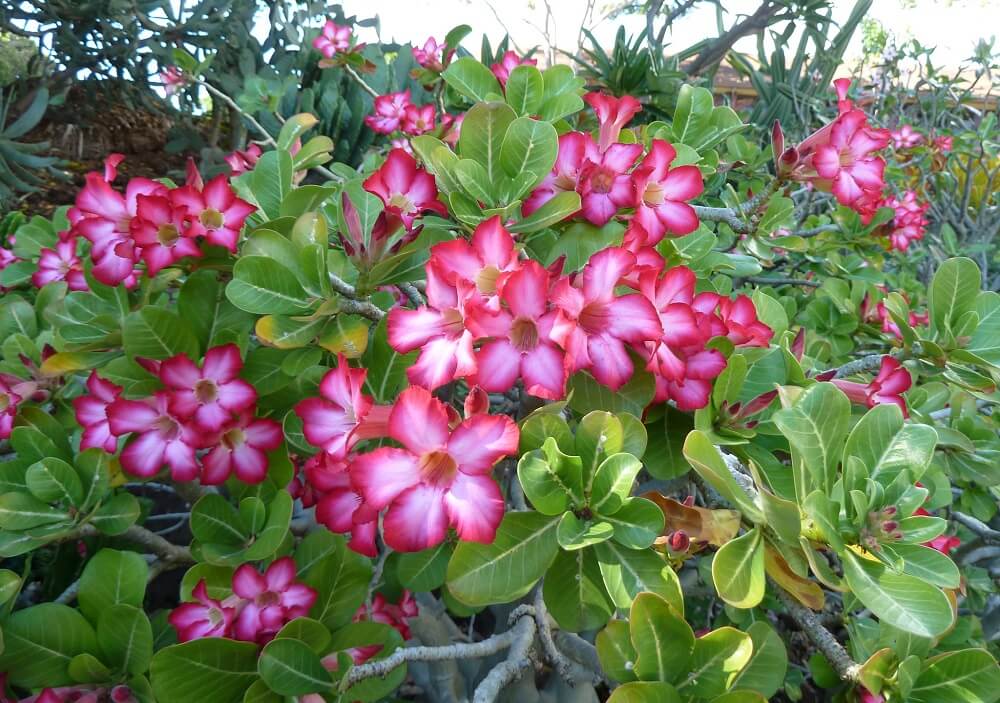
Adenium obesum is a flowering succulent tree that stores water in the thick, broad base of the trunk meets the top of the roots. This juncture is called the plant’s caudex. The Adenium caudex is judged to be nearly as desirable as its flashy blooms. Adenium grow up to 9 feet tall in their native land but readily take to containers where they can be kept much smaller. Plant in fast-draining succulent soil with the caudex exposed above the soil line. Provide bright sunlight and enjoy spectacular blooms in spring and summer once the plant is three years old.
Portulaca oleracea
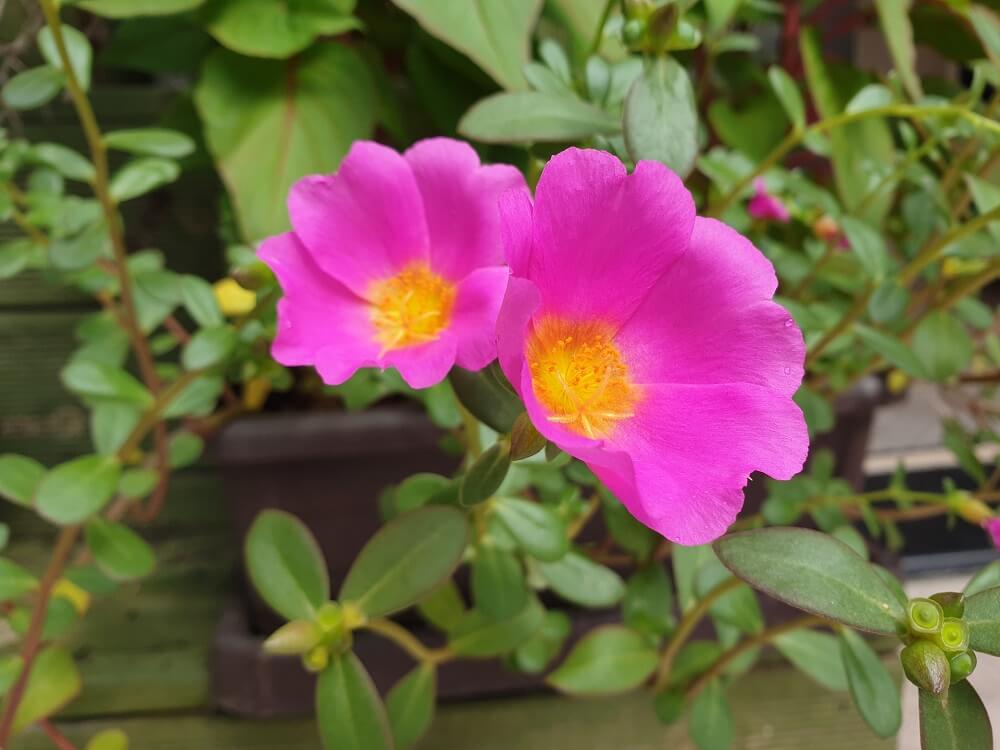
This fast-growing, heavy-blooming beauty grows as an annual and simply covers itself with Portulaca oleracea is a flowering succulent that goes by many common names, including purslane, duckweed, little hogweed, pursley, and a tasty side dish. Really? It is chock full of vitamins A and C and various minerals, and it contains a super high amount of omega-3s! This fast-growing, easy-care succulent annual thrives in full sun and blooms heavily in bright shades of pink, yellow, orange, and white. Hardy to 30°F (-1.1°C)
Sedum telephium ‘Autumn Joy’
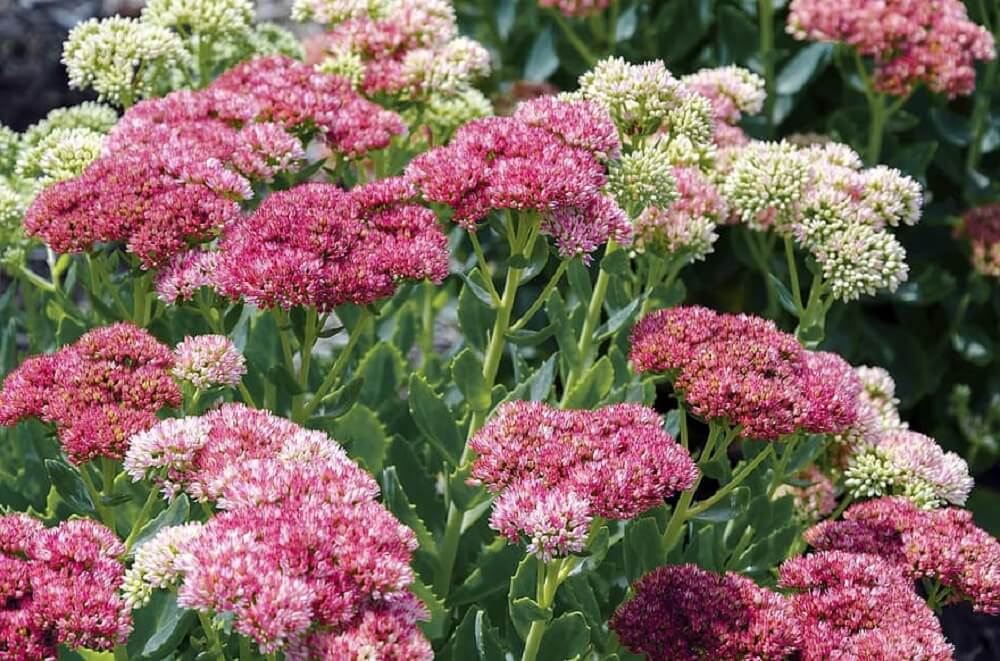
Sedum telephium ‘Autumn Joy’ is one of the “border sedums” and surely one of the very best. The foliage forms loose rosettes reaching 10-12″ tall. Fall sees the plant cover itself with dense clusters of blooms ranging from creamy white to bright pink. These long-lasting blooms are highly attractive to bees and butterflies. In winter, the plant goes dormant and dies back to the ground. Spring sees a revival with fresh, lush foliage quickly emerging. Sedum ‘Autumn Joy’ is a cold-hardy succulent flowering plant, tolerating temps down to zone 4 (-30°F / -34.4°C).
Flowering Succulents Frequently Asked Questions (FAQs)
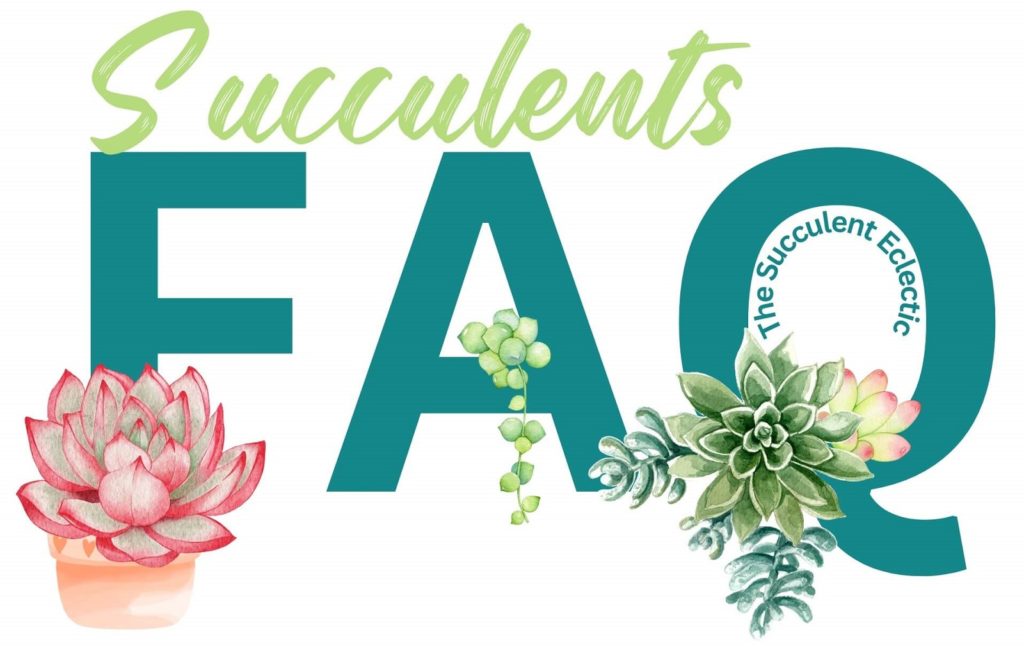
Are there any succulents that flower?
All succulents are flowering plants. Some bloom every year, others do so only when the conditions are just right. Some may take many years before they flower. Some succulents (monocarps) bloom just once in their lifetime while most bloom many times.
Are succulents dying when they bloom?
Some succulent varieties bloom once in their lifespan and then die. These are monocarpic succulents and their flowers are often referred to as “death blooms.” Most succulents, however, bloom many times in their lives. These are called polycarpic succulents.
What to do when succulent starts flowering?
Whether to cut a succulent’s flower or let it bloom is up to you. Flowering succulents attract and support local pollinators. They also develop seeds that can be used for propagation. However, the flowering does drain energy from the plant and can attract pests. Cut succulent blooms can last for weeks in a vase.
What succulent dies after flowering?
While most succulents can bloom over and over again, monocarpic succulents bloom just once in their lifetime and then die. Depending upon the variety, this may take a few years or several decades! Monocarpic succulents include:
• Aeonium
• Agave
• Aichryson
• Furcraea
• Jovibarba
• Orostachys
• Sempervivum
• Sinocrassula
Are You Ready to Grow Some Flowering Succulents?
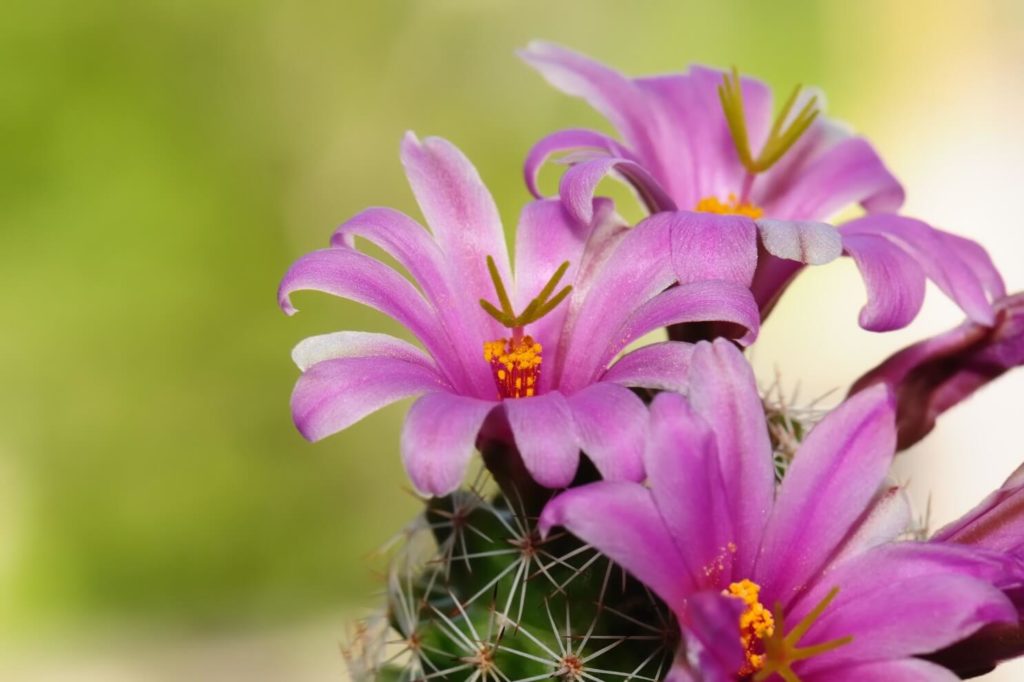
Whew! There you have it! A complete guide to flowering succulents, including care, pollinators, death blooms, and my top 16 recommendations. Rest assured, there are many (many) more succulents that bloom beautifully. I just had to stop somewhere. Did I miss anything you have a question on? Or did I skip a succulent flowering plant you think deserves a shout-out? If so, please take a moment to leave a comment and let me know! I just love hearing from you, and I’ll always get right back to you.
Because life is just better with (flowering) succulents! 🙂

P.S. For my FREE course on succulent care, 7 Steps to Succulent Success, please subscribe! Thank you!
P.P.S. Why not join my Facebook Group for succulent lovers? We talk about succulent care, propagation, succulent identification, and design. It’s a warm and welcoming group that would love to meet you!
